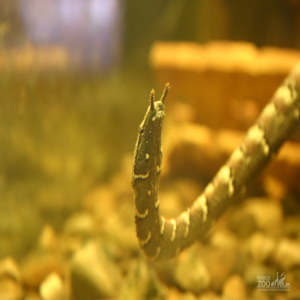 The tentacled snake is an aquatic snake easily identified by the pair of short, scaly appendages that extend from the front of its snout. Its head and body are extremely flat, and its coloring varies from light brown with dark stripes to dark gray with light-brown mottling. This color and pattern can resemble a twig or branch with mottled, water-soaked bark. The snake’s scales are keeled and feel rough like sandpaper. Tentacled snakes are diurnal and aquatic. The nostrils are dorsally positioned and valvular – specialized tissue allows them to close. They grow to about 19 – 20 inches long.
The tentacled snake is an aquatic snake easily identified by the pair of short, scaly appendages that extend from the front of its snout. Its head and body are extremely flat, and its coloring varies from light brown with dark stripes to dark gray with light-brown mottling. This color and pattern can resemble a twig or branch with mottled, water-soaked bark. The snake’s scales are keeled and feel rough like sandpaper. Tentacled snakes are diurnal and aquatic. The nostrils are dorsally positioned and valvular – specialized tissue allows them to close. They grow to about 19 – 20 inches long.
Location: The Lower RainForest
Share:
Range
Southeast Asia, including Vietnam, Thailand and Cambodia
Habitat
They inhabit fresh or brackish water, streams, ditches, sloughs and rice paddies. They like slow-moving or stagnant bodies of water with vegetation just below the water line. In dry seasons they will bury themselves in the mud until the rain comes.
Conservation Status
Least Concern
Primary Threats
Gestation
Unknown
Litter
The litters are between 5 – 13 young
Behavior
Underwater they rely on their cryptic pattern and coloring for camouflage to avoid predators. If investigated by an approaching animal, the tentacle snake extends its body, becoming completely rigid. It maintains this position even if removed from the water, which further enhances its ability to resemble a water-soaked branch. Tentacled snakes do not vocalize, but their visual and sensory perception systems appear to be integrated. Their tentacles detect the presence of other animals. They use both their sense of touch and vision to perceive their surroundings.
Reproduction
This species is ovoviviparous, meaning it bears live young that have hatched from eggs within the female.
Wild Diet
Tentacled snakes feed almost exclusively on fish but have been observed eating frogs and sometimes crabs. They are rear-fanged, and various species seem to have specialized venom for their preferred prey. As a potential meal approaches, the snake “bumps” out part of its body creating a wave in the direction of the prey. The fish changes direction to the jaws of the snake. This bump is so quick that it takes high-speed film to observe.
Zoo Diet

